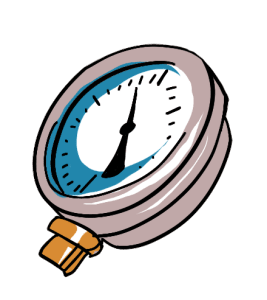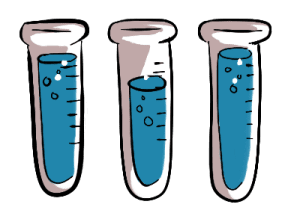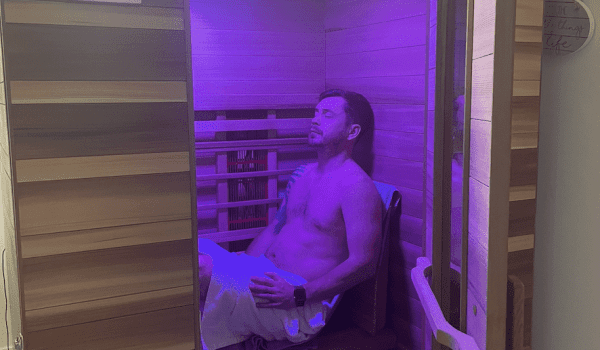In a perfect world, you could just pour water and salt into a float pod and it would stay pure and clean and fresh and salty forever. In the real world, conditions in the water are constantly changing, so keeping our water in perfect condition takes a fair amount of work and vigilance.
Water that isn’t maintained properly can lead to bad float experiences and become unsanitary and unsafe.
We test the condition of our water twice a day using a variety of measurements, basically one for every important variable water condition. Because some of our tests take a bit of time, we gather water samples from the tanks in between floats and perform measurements later when we aren’t busy transitioning rooms and checking in floaters.
Everyday, we check the following conditions in our tanks – temperature, filter, water depth, specific gravity, free chlorine, alkalinity, and pH levels.

To test the temperature of the water in our tanks, we use a handheld, high resolution, precision reference thermometer. These are the types of thermometers often used to measure the accuracy of other thermometers.
Most handheld thermometers are rated to have an accuracy variance of +/- 1 to 2 degrees f. This won’t cut it in the world of float tanks where a difference of only half a degree might be enough to ruin a float. So we opted to spend more money on a reference thermometer with an accuracy of around to +/- .05 degrees.
Many tanks come with built in thermometers. Do not assume that these readings are accurate, they may need to be calibrated and re-calibrated. We have built in thermometers on four of our six tanks, and none of them are currently accurate. That is why we use the reference thermometer.
Filter PSI

The filter psi measures the amount of water pressure flowing through our pumps in pounds per square inch. The reading is taken from one or two pressure gauges (two if you want to measure pressure pre and post filter) attached to the filter system. Filter PSI readings can indicate whether your pumps are functioning properly, getting the required level of flow for proper filtration, or if the system is in need of a filter change.
Water Depth
This is an easy one, we have a scale inbuilt into our pods, and we check to ensure the water is at the set level.
Specific Gravity

In order to determine how buoyant (and thus how salty) our water is, we use a tool called a hydrometer to measure the specific gravity.
A hydrometer is a weighted glass bulb and stem with measurement markings on it. We fill up a graduated cylinder with tank water, then sink the bulb of the hydrometer into the water so that it sinks as far as it can without touching the bottom of the cylinder. The stem of the hydrometer is then poking up out of the water, and the number that is right at the waters surface is the specific gravity. It’s important to note to hold the hydrometer away from the tank when measuring. It’s an expensive mistake if you hold it over the tank and drop it…
Specific gravity is a measurement of the ratio of the density of our tank water to that of pure H2O. We try to keep our specific gravity around 1.280, meaning our salty pod water is 1.28 times as dense normal water. If the specific gravity gets too high your tank water might pass it’s saturation point – it will be unable to absorb anymore salt and crystals will start to form. If the specific gravity is too low it makes it harder to float.
Gathering Water Samples

Because of the time it takes to do the next three tests, we carry around plastic color coded 125 milliliter vials with screw on caps to each of the tanks and pull a sample of water from each to test in between floats. The vials are labelled with a number corresponding to each tank so that we won’t mix up the samples and forget which came from which tanks.
Why We Avoid Test Strips
The next three tests for Trichlorine, Alkalinity, and pH levels are often performed with test strips at other float centers. While test strips may be fine in general, we felt like reading them could be too subjective (how dark does this color orange look to you?) and left more room for error than we were comfortable with. The strips get old and stop working properly, they can get contaminated, they appear darker or lighter depending on ambient light conditions, etc. So at The Float Spa, we decided on more accurate, more labour intensive testing methods that left less room for subjectivity and error.
Trichlorine
We use trichlorine as a sanitizing agent in our tank water, this is a precursor to chlorine and we dose using a slow release tablet to ensure the correct amount of trichlorine at all times.
To measure our trichlorine levels, we use a Colorimeter. It’s a little device that holds a water sample and shoots a beam of light through it. You then add a reagent to the same sample, put it back in the machine, it shoots the light through it again and gives an chlorine reading based on the difference between the light readings before and after the chemical reagent is added.
Alkalinity
For our alkalinity test, we use an Alkalinity Colorimeter. It’s a little device that holds a water sample and shoots a beam of light through it. You then add a reagent to the same sample, put it back in the machine, it shoots the light through it again and gives an Alkalinity reading based on the difference between the light readings before and after the chemical reagent is added. We try to keep our Alkalinity between 80 and 120.
PH
We measure the pH using a digital handheld pH meter. This is a fairly easy to use device, we just dip the tip into a water sample like a thermometer. It does take the machine a minute or more to settle on an exact reading, which is why we test samples rather than test the water directly in the tank. The digital pH meter also required careful storage and care, and will need to be calibrated from time to time. We feel it’s a reasonable trade off for higher accuracy. We try to keep our pH around 7.0, as most regulatory bodies consider 6.9 – 7.2 the ideal range.
Record everything and keep track of what you add
After we take all these measurements, we record them in our water diary. In addition to measuring the water conditions, we also record and track the amounts of chemicals we add to the tank (water, salt, trichlorine, alkalinity up, ph+ or ph-) and every time we alter the temperature setting or change filters. Over time, we get a clear idea what measurements we should be getting each morning, of roughly how much salt to add weekly, how often to change filters, and so on.










